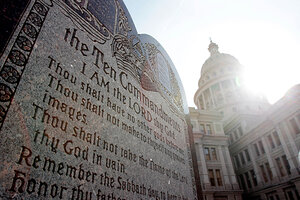Supreme Court refuses appeal about Ten Commandments displays
The Supreme Court had struck down earlier Ten Commandments displays at the same Kentucky courthouses in 2005. The displays were altered, but a federal judge issued a permanent injunction against them.

A monument with the Ten Commandments sits on the north side of the Texas capitol on Jan. 6, in Austin, Texas. The Supreme Court struck down earlier Ten Commandments displays at the same Kentucky courthouses in 2005, ruling that officials had an impermissible religious purpose in authorizing those displays. That decision was handed down on the same day the court upheld a Ten Commandments display on public land in Austin, Texas.
Eric Gay/AP
Washington
The US Supreme Court declined on Tuesday to take up a case examining whether Ten Commandments displays in two county courthouses in Kentucky were an unconstitutional endorsement of religion in violation of the First Amendment.
The action by the justices came without comment.
The high court struck down earlier Ten Commandments displays at the same locations in 2005, ruling that officials had an impermissible religious purpose in authorizing those displays. That decision was handed down on the same day the court upheld a Ten Commandments display on public land in Austin, Texas.
The two cases together represented an effort by the Supreme Court to mediate what had become a running battle between groups seeking to protect the display of religious symbols on public property and others who oppose the display of such symbols as a violation of the separation of church and state.
In the latest case, lawyers for McCreary and Pulaski Counties contended that they had removed any unconstitutional taint from the earlier displays since the Supreme Court’s decision in 2005. The counties included the Ten Commandments as part of a broader presentation of historic documents. The newer displays contained part of the Declaration of Independence, the Mayflower Compact, the national motto, and other statements referring to God and the Bible.
The displays were meant to convey the message that religion and faith are part of the foundation of the country, officials said.
As in the earlier case, the American Civil Liberties Union of Kentucky sued to block the displays, arguing that they amounted to an unconstitutional attempt by government officials to spread a religious message.
A federal judge agreed with the ACLU and issued a permanent injunction against the displays. The ruling was upheld 2 to 1 by the Sixth Circuit Court of Appeals.
The Sixth Circuit said the First Amendment bars the establishment of religion by the government and requires government neutrality between religions as well as between religion and nonreligion.
The appeals court said it found little evidence that the counties’ intent in hosting the Ten Commandments displays had changed from an impermissible religious motive to a permissible secular purpose.
“It is clear that these resolutions, like the previous statements of purpose, were adopted only as a litigating position,” the court said.
“Defendants have continuously sought to defend their actions and accomplish what they initially set out to do,” the appeals court said.
The majority judges said the officials’ overall purpose was still the unconstitutional use of government property and resources to spread a religious message.
In his brief to the Supreme Court on behalf of the two counties, lawyer Mathew Staver urged the justices to take up the case and use it as a vehicle to articulate a new establishment-clause standard to apply to government displays with religious content on public property.
“The confusion resulting from the lack of a coherent Establishment Clause standard will only continue to grow until this Court steps in to provide the objective standards legislators need to avoid falling into Establishment Clause traps,” Mr. Staver wrote.
“This Petition provides this Court with the opportunity to finally tear down the walls of the labyrinth of Establishment Clause jurisprudence,” he said.
